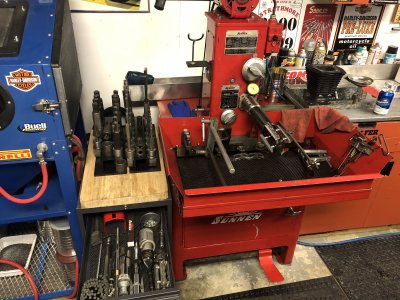A good experienced operator can straighten out a wookety bore on a sunnen machine , not so easy with a drill powered rigid hone , the reason being , a dedicated honing machine has a built in bore gauge , in tenths to get a visual on material being removed and the needle will sweep when there is taper or the bore is out of round . It takes experience and finesse to make a wookety hole round , the trick is to interpret what you are seeing on the guage , think about it and take corrective action , without screwing up the hole , making it worse or blowing over the desired final size.
With a drill mounted rigid hone you gotta wing it , measure lots and find the areas of the bore that require more stroking , take corrective action , more measuring , if you are both lucky AND good , it all turns out.
To clarify ...... , the abrasive stones and guide shoes on a Sunnen hone machine follow the bore , if irregularities exist the dial gauge built into the machine displays the variance . What the operator does with that is up to him , it can turn out well in the hands of an experienced guy or it can go sideways in a hurry .
As material is removed from the bore , constant measuring with a hand held bore guage is necessary to keep the sizing and "straight-ness" under control .
View attachment 28745
The guage is above the spindle and is connected directly to the mechanism that retracts the stones as well as the adjustment handle ( above the guage ) which sets the desired size of the stones within the bore . There is a second dial handle which allows the operator to set the cutting pressure . Then there are a multitude of available stones in several grits for various sizes and materials , it's complicated , at first and expensive too , no one said any of this is cheap , it's frighteningly costly to get a machine and properly outfit it , the learning curve/ experience part is when you actually get to stand at the machine and run it.


